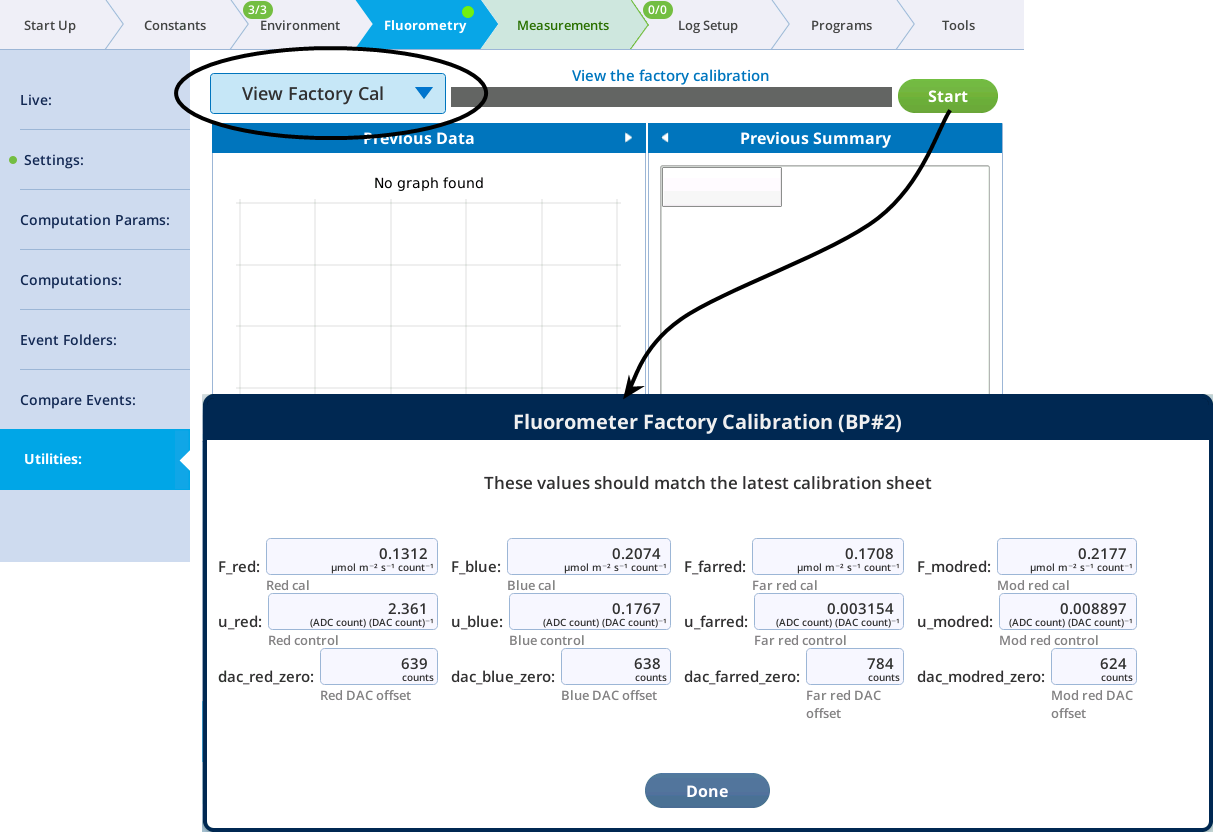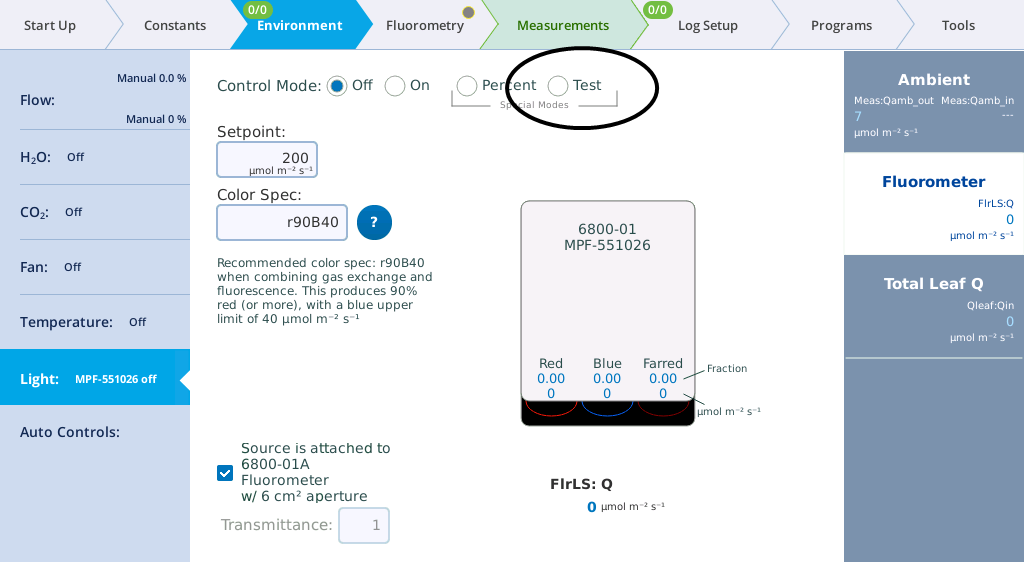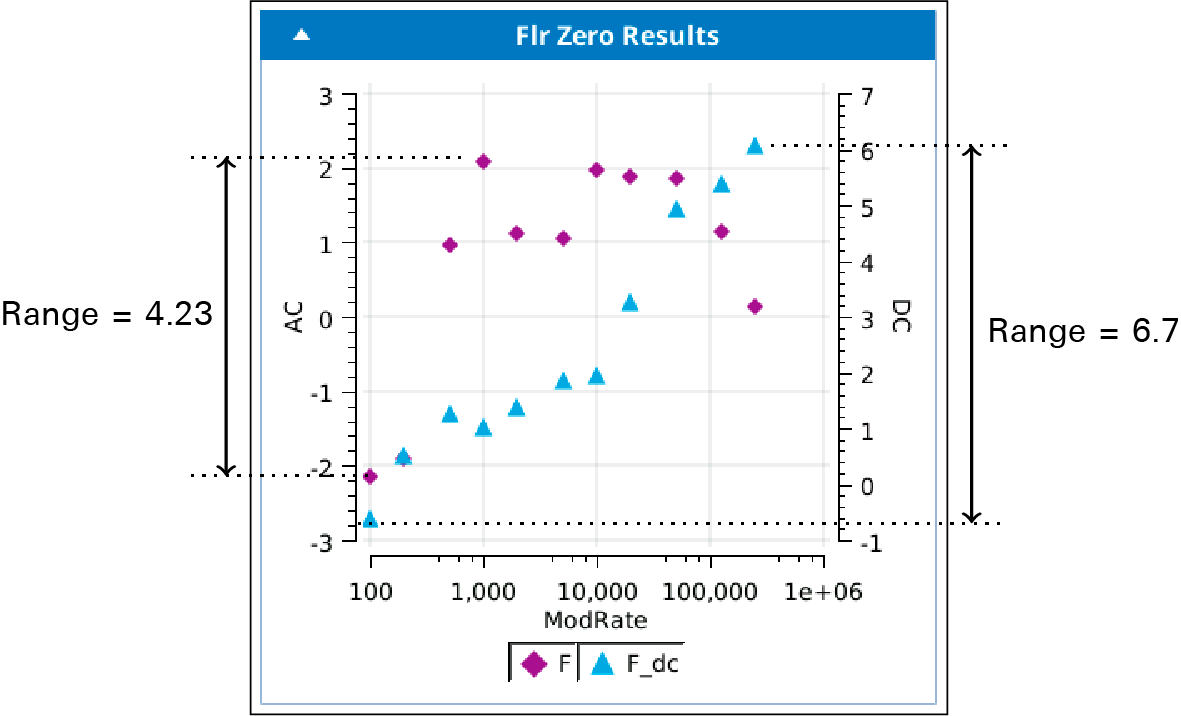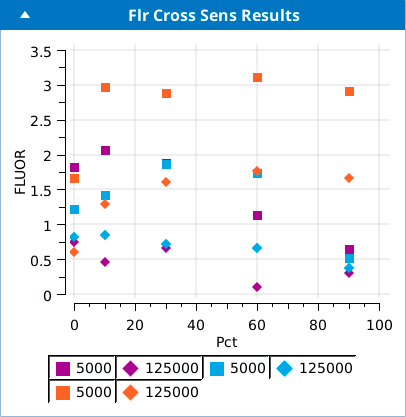Fluorometer tests
When a fluorometer is connected, the fluorometer tests are available from the menu.
Cal values
The fluorometer calibration value tests factory calibration factors. The first 12 tests check each of the calibration values against a range of expected values, and warns about outliers. If there is a warning here, check the cal sheet to be sure the entered value is correct. If it is, trust the calibration sheet over the expected value, and ignore the warning.
Pass Test 1: Is F_red = 0.2 +/- 0.15 ? Measured= 0.12818
Pass Test 2: Is F_blue = 0.2 +/- 0.15 ? Measured= 0.174674
Pass Test 3: Is F_farred = 0.2 +/- 0.19 ? Measured= 0.175743
Pass Test 4: Is F_modred = 0.2 +/- 0.19 ? Measured= 0.202304
Pass Test 5: Is u_red = 2.5 +/- 2.0 ? Measured= 2.54922
Pass Test 6: Is u_blue = 0.2 +/- 0.15 ? Measured= 0.203029
Pass Test 7: Is u_farred = 0.003 +/- 0.002 ? Measured= 0.003662
Pass Test 8: Is u_modred = 0.03 +/- 0.029 ? Measured= 0.009615
Pass Test 9: Is dac_red_zero = 600 +/- 300 ? Measured= 653.0
Pass Test 10: Is dac_blue_zero = 600 +/- 300 ? Measured= 742.0
Pass Test 11: Is dac_farred_zero = 800 +/- 300 ? Measured= 752.0
Pass Test 12: Is dac_modred_zero = 600 +/- 300 ? Measured= 624.0
If a value falls outside the expected range, then this suggestion is produced:
Make sure this is what is on the fluorometer's calibration sheet.
Fixing a value involves a visit to the fluorometer calibration dialog:
The next two tests check the far red LEDs, the actinic photodiode, and the fluorescence photodiode. We look at the effect of far red LEDs on the actinic detector (PC) and the fluorescence detector (DC). The slope of the response (counts per percent far red power) is logged and compared with expected values.
Checking farred response
Pass Test 13: Do farred LEDs affect PC? Expect PC/% > 1. Measured 2.3
Pass Test 14: Do farred LEDs affect DC? Expect DC/% > 50. Measured 115.0
If one slope fails, it is a warning:
Is the face of the fluorometer dirty and blocking light?'
If both slopes are near zero, then an error is produced with this suggestions:
Far red LEDs may not be working. Contact LI-COR
Tests 15-18 are a firmware check of the fluorometer, but will fail if the modulation LEDs can't hit a peak value of 100 µmol m-2 s-1, which corresponds to a average output (REDMODAVG) of 5 µmol m-2 s-1 when modulated at 50 kHz, and 0.01 µmol m-2 s-1 when modulated at 100 Hz.
Testing autoselection of modulation rate
Pass Test 15: With Q=172.0, is REDMODAVG=5.0 0.01? Measured 5.0
Pass Test 16: With Q=0.0, is REDMODAVG=0.01 0.01? Measured 0.01
Pass Test 17: With Q=165.0, is REDMODAVG=5.0 0.01? Measured 5.0
Pass Test 18: With Q=33.0, is REDMODAVG=0.01 0.01? Measured 0.01
The suggestion when not hitting the 5.0 target is:
Weak modulation? Modulated cannot reach 100 mol m-2 s-1? Contact LI-COR.
The suggestion when not hitting the 0.1 target is:
Fluorometer firmware or communications fault. Contact LI-COR.
Tests 19 and 20 are another firmware check.
Testing REDMODAVG and PFD computations
Pass Test 19: With REDMODAVG=4.99982 and actinic off, does PFD read 4.99982? Measured 4.99982
Pass Test 20: With REDMODAVG=0 and actinic off, does PFD read 0? Measured 0
An error here produces this suggestion:
Fluorometer firmware or communications fault. Contact LI-COR.
Actinic 1st response
During operation, when an actinic setpoint is specified, an active controller (active means it’s watching the detector output) drives the light to the target value in typically 5 to 10 seconds depending on the step change. The Actinic 1st response test bypasses that, and takes the light immediately to a "first guess" value, leaving it there. It does this for a series of red, blue, and farred target values, and results are expected to be within 10% of the target value, or 20 µmol/m2/s, which ever is larger).
Pass Test 1: farred. Is Q = 5.0 +/- 20? Measured=5.4
Pass Test 2: farred. Is Q = 10.0 +/- 20? Measured=10.6
Pass Test 3: farred. Is Q = 20.0 +/- 20? Measured=20.5
Pass Test 4: blue. Is Q = 20.0 +/- 20? Measured=17.7
Pass Test 5: blue. Is Q = 100.0 +/- 20? Measured=90.8
Pass Test 6: blue. Is Q = 500.0 +/- 50.0? Measured=481.1
Pass Test 7: blue. Is Q = 800.0 +/- 80.0? Measured=778.6
Pass Test 8: blue. Is Q = 1000.0 +/- 100.0? Measured=977.2
Pass Test 9: red. Is Q = 20.0 +/- 20? Measured=21.2
Pass Test 10: red. Is Q = 800.0 +/- 80.0? Measured=807.9
Pass Test 11: red. Is Q = 1500.0 +/- 150.0? Measured=1516.8
Pass Test 12: red. Is Q = 5000.0 +/- 500.0? Measured=5072.5
Pass Test 13: red. Is Q = 10000.0 +/- 1000.0? Measured=10134.2
Pass Test 14: red. Is Q = 15000.0 +/- 1500.0? Measured=15112.8
Pass Test 15: red. Is Q = 200.0 +/- 20.0? Measured=202.2
Failures here would indicate that something has shifted since the factory calibration. It could be in the relation between controller current and light output, or in the relation between light output and photodiode signal. Or both. Slight failures can probably be ignored, since the active controller for setpoint control never uses first guesses. Large failures may merit returning the fluorometer to LI-COR for a re-calibration.
Values out of range are a warning. If the target intensity is <100, a zeroing suggestion is produced.
Check the PC (actinic photodiode) zero.
For higher intensities, specific cal values are targeted for checking. For example, if it is red light:
Compare cal sheet to factory cal. Specifically, the F_red, u_red, and dac_red_zero values.
Fluorometer may need recalibration. Contact LI-COR.
Note that this first response mode is available for use or manual testing by selecting the Test option in the fluorometer actinic control page.
Actinic control
The actinic control test does a controller test on actinic control. A series of random setpoints and colors are used for setpoints, and the time it takes for the fluorometer to stabilize at the new target is recorded.
Pass Test 1: Is Q within 1.0 of 1032 umol m-2 s-1? Measured 1031.65 after 13.5s
Pass Test 2: Is Q within 1.0 of 794 umol m-2 s-1? Measured 794.424 after 10.5s
Pass Test 3: Is Q within 1.0 of 1406 umol m-2 s-1? Measured 1405.967 after 12.5s
Pass Test 4: Is Q within 1.0 of 1145 umol m-2 s-1? Measured 1145.747 after 9.5s
Pass Test 5: Is Q within 1.0 of 1562 umol m-2 s-1? Measured 1561.34 after 9.5s
Pass Test 6: Is Q within 1.0 of 617 umol m-2 s-1? Measured 617.342 after 12.0s
Pass Test 7: Is Q within 1.0 of 880 umol m-2 s-1? Measured 879.114 after 9.0s
Pass Test 8: Is Q within 1.0 of 951 umol m-2 s-1? Measured 950.459 after 8.0s
Pass Test 9: Is Q within 1.0 of 1049 umol m-2 s-1? Measured 1048.883 after 9.5s
Pass Test 10: Is Q within 1.0 of 383 umol m-2 s-1? Measured 383.375 after 11.5s
Fluorometer zero
The fluorometer zero test measures the effect of modulation rate on the AC and DC (i.e., modulated and non-modulated) fluorometer zero. The range of measured values is compared with an expected typical range.
Testing 100 Hz modulation rate
Testing 200 Hz modulation rate
Testing 500 Hz modulation rate
Testing 1000 Hz modulation rate
Testing 2000 Hz modulation rate
Testing 5000 Hz modulation rate
Testing 10000 Hz modulation rate
Testing 20000 Hz modulation rate
Testing 50000 Hz modulation rate
Testing 125000 Hz modulation rate
Testing 250000 Hz modulation rate
Pass Test 1: Is range of F < 10? Measured 4.23
Pass Test 2: Is range of F_dc < 20? Measured 6.7
Warnings for modulated fluorescence (F):
Is the chamber closed and empty? And clean inside?
To assess if this range of zero shift is significant, compare:
a) the zero difference between the flash and measuring modulation rates.
b) the typical magnitude of F during a flash.
Warnings for dc fluorescence (F_dc):
This might indicate an above-average temperature sensitivity of the fluorescence detector.
If there is no problem with the F zero shift, the following is included in the suggestion list:
The F zero shift is ok, so you can probably ignore this.
Fluorometer cross sensitivity
The fluorometer cross sensitivity test checks modulated fluorescence for any cross sensitivity with actinic light output. Red, blue, and farred are tested individually by ramping each from 0 to 90 percent of full power. The slope and intercept of the modulated fluorescence as a function of light intensity is then determined. This is done for two modulation rates, 5000 Hz and 125 kHz. Intercept values should be near 0, and slopes should be flat. A significant positive slope would indicate a cross sensitivity problem.
Checking cross sensitivity to red
Pass Test 1: red 5000Hz: Regressed intercept - measured < 5? Measured 0.5
Pass Test 2: red 5000Hz: Response slope < 0.05? Measured -0.0187
Pass Test 3: red 125000Hz: Regressed intercept - measured < 5? Measured -0.17
Pass Test 4: red 125000Hz: Response slope < 0.05? Measured -0.004
Checking cross sensitivity to blue
Pass Test 5: blue 5000Hz: Regressed intercept - measured < 5? Measured 0.71
Pass Test 6: blue 5000Hz: Response slope < 0.05? Measured -0.0114
Pass Test 7: blue 125000Hz: Regressed intercept - measured < 5? Measured 0.1
Pass Test 8: blue 125000Hz: Response slope < 0.05? Measured -0.0056
Checking cross sensitivity to farred
Pass Test 9: farred 5000Hz: Regressed intercept - measured < 5? Measured 1.3
Pass Test 10: farred 5000Hz: Response slope < 0.05? Measured 0.0001
Pass Test 11: farred 125000Hz: Regressed intercept - measured < 5? Measured 0.77
Pass Test 12: farred 125000Hz: Response slope < 0.05? Measured 0.0045
Faults are warnings, with these suggestions:
Is the chamber closed and empty? And clean inside?
Otherwise, contact LI-COR.
Passing these tests is primarily a product of optical filter choice and electronic design - things that stay constant through the life of the fluorometer, so failures are not expected. Should one occur, it may be because of something simple, such as the presence of fluorescing material in the chamber, or - the worst case - it could mean that a fault had developed (contamination, breakage, etc.) with the optics or electronics, in which case LI-COR service is needed.
If there is a warning that can't be fixed, and factory service is not an immediate option, then you should evaluate the impact of the cross sensitivity on your measurements: Cross sensitivity to red is probably most serious, since F will be different during a flash (high red) than during a measurement (low red) just due to cross sensitivity. Try an empty chamber flash and see what the effect on F is, then determine if that effect warrants post-measurement correction. Cross sensitivity to far red will affect dark pulse readings, but only while the far red is on, and the Fo' value is recorded after the far red is off, so if that is the only time you use far red, then it may not be an issue. Cross sensitivity to blue is hard to explain outside of an electronic fault, but if your unit has a blue issue, and if it is stable, then it would not be an issue for fluorescence measurements at a constant (actinic) light, but would be an issue when comparing (Fs, for example) two different actinic levels.




